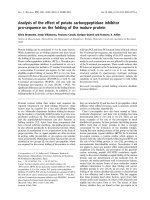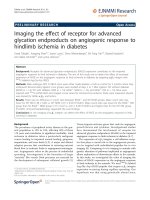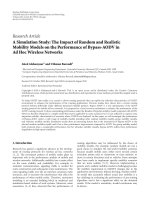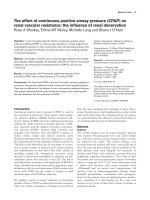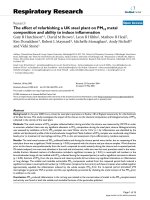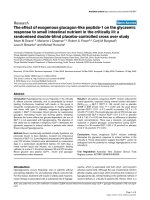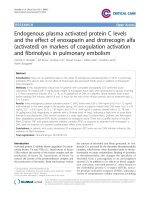Study the effect of probiotic bacteria isolated from foods on pathogens
Bạn đang xem bản rút gọn của tài liệu. Xem và tải ngay bản đầy đủ của tài liệu tại đây (169.57 KB, 8 trang )
Int.J.Curr.Microbiol.App.Sci (2018) 7(7): 4127-4134
International Journal of Current Microbiology and Applied Sciences
ISSN: 2319-7706 Volume 7 Number 07 (2018)
Journal homepage:
Original Research Article
/>
Study the Effect of Probiotic Bacteria Isolated From Foods on Pathogens
Abeer Abu Zaid1,2*
1
Department of Special food and nutrition, Food Technology Research Institute,
Agricultural Research Center, Giza, Egypt
2
Biology Dept., Fac. of Science, Taif University, Saudi Arabia
*Corresponding author
ABSTRACT
Keywords
Probiotic strains, Bacillus
sp., Antibacterial.
Antibiotic,
Gastrointestinal tract
conditions
Article Info
Accepted:
28 February 2018
Available Online:
10 July 2018
Eleven Bacillus strains were isolated from foods and evaluated their probiotic potential
and safety. Then study the effect of selected strains against pathogens, and on the
population of pathogens in reconstituted skim milk (RSM).Seven strains from Bacillus sp.
(3) and Bacillus subtilis (4) were selected which were grow in low pH 1.0 to 5.0 and
tolerant bile salt 0.3 to 2%, highly resistant to simulated gastrointestinal tract conditions,
and showed antimicrobial activity against Salmonella typhimurium ATCC20231 and
Staphylococcus aureus ATCC25923. They had antibiotic susceptibility against 6tested
antibiotics. Also, it‟s exhibited non-hemolytic on sheep blood. Two pathogens were
completely inhibited after 60 and 72hrs of incubation with selected probiotic strains in
RSM. The results indicate that Bacillus subtilis or Bacillus sp. could be used as probiotic
cultures for animal feeds and human, fermented vegetables, milk, meat product as well as
to achieve biopreservation of dairy products in food industries.
Introduction
Food borne illness are major international
health problems in the world wide and
reduced the economic growth (WHO, 2007),
although enhanced performance of effective
legislative control on food processing
procedures in industries. Food borne diarrheal
diseases are causes of illness and death~2.2
million people annually and over than 200
types of illness transmitted by food (Mensah
et al., 2002 & Lynch et al., 2006). These
pathogens are Listeria monocytogenes,
Staphylococcus aureus, Escherichia coli,
Salmonella typhi, Bacillus cereus, yeasts and
moulds. The use of naturally produced anti-
microbial agents without any adverse effects
on human health to inhibit the propagation of
pathogenic microorganisms in foods, that is
may be challenge the problems associated
with food contamination.
The expression of “probiotics” was
plagiaristic from the Greek word, it is
meaning as “for life” (Reid et al., 2003). After
that, FAO/WHO (2006) were defined
probiotics as: “Live microorganisms‟‟ which
when administered in sufficient amounts
confer a beneficial health to host by
improving its microbial balance in gut (Aslam
and Qazi, 2010). Probiotic bacteria may be
producing various Anti-microbial metabolites,
4127
Int.J.Curr.Microbiol.App.Sci (2018) 7(7): 4127-4134
which include organic acids (lactic and acetic
acids), and bacteriocins. The organic acids not
only lower the pH, but they can also be toxic
to the pathogens. The beneficial of probiotic
bacteria are prevention and treatment of
diseases in gastrointestinal disturbances, such
as dysentery, diarrhoea, typhoid (Tambekar
and Bhutada, 2010).
Lactobacillus, Bifidobacterium, Lactococcus,
Leuconostoc, Bacillus and many others are
integrated in the list of probiotics (Isolauri et
al., 2004). Probiotics are well recognized to
possess specific properties such as; gastric
juice and bile tolerance, adhesion to the
epithelial cells of the intestine, survive in the
gastrointestinal tract of humans and animals
and improvement of the intestinal microbial
balance (Ministry of Food and Drug Safety,
2015).
Probiotics
bacteria,
like
common
microorganisms, it may possess undesirable
properties such as the advent of harmful
biochemical and virulence factors. They are
non-spore former, and may be destroyed in
high bile concentrations of the duodenum and
stomach acids. Therefore, large numbers from
probiotics bacteria were require surviving in
the gut anaerobic. To challenge this problem,
many studies are in progress on the
applicability of a new spore forming Bacilli
probiotics, such as; Bacillus coagulans,
Bacillus subtilis, Bacillus licheniformis,
Bacillus polymyxa, and Bacillus mesentricus.
They are non-pathogenic and naturally found
in water and soil, ferment a large number of
sugars, secrete protease, lipase and amylase
enzymes, survive in the stomach and reach
the intestine to germinate, and thermo stable.
Bacillus species are Gram positive bacilli,
produce heat resistant spores and wide spread
in environment or many types of food.
B.subtilis is not harmful to mammals,
including humans, and is commercially
important as producer of a high fine
chemicals and enzymes and diverse amount
of secondary metabolites like antibiotics, as
well as heterologous proteins, antigens and
vaccines (Stein, 2005; Bérdy,2005 &Valdez
et al., 2014]. B.subtilis grow efficiently with
low-cost carbon and nitrogen sources,
because its enzymes are very efficient
breaking down a great variety of proteins,
carbohydrates and lipids from animal and
vegetable origin, into their constituent units
(Ochoa, 2012). B. subtilis spores have the
ability to resist extreme pH conditions, UV
irradiation, high temperatures, solvents and
long time periods of storage without
refrigeration [Sonnenschein et al., 1993]. In
review, B. subtilis has adaptability of growth
nutrients utilization, production high level of
enzymes,
secretion
of
antimicrobial
compounds, develops in aerobic and
anaerobic conditions, and B.subtilis is
Generally Recognized As Safe (GRAS) by
the Food and Drug Administration (FDA).
Finally, B. subtilis in “theory” may be well
measured as a ideal multifunctional probiotic
bacterium for hosts (Cutting, 2011; Olmos et
al., 2011; Sorokulova, 2013; Huang et al.,
2013 & Olmos et al., 2014).
The aim of this study to evaluate thepotential
probiotics properties of Bacillus bacteria
isolated from food, and their antibacterial
effects against pathogenesis. Finally study the
effect of co-culturing probiotic bacteria with
pathogenic in skim milk.
Materials and Methods
Bacterial strains
Eleven bacterial strains (M01 –M11) were
isolated under aerobic conditions from twelve
traditional food products; further all strains
were identified by partial 16SrRNA gene
sequencing and phylogenetic analysis. All
strains were identified by 97-100% identity
4128
Int.J.Curr.Microbiol.App.Sci (2018) 7(7): 4127-4134
including Bacillus circulans (4), Bacillus sp.
(3) and Bacillus subtilis (4) according to Abu
Zaid et al., (2015). Standard Biochemical
tests such as gram reaction, spore former,
motility, catalase reaction, oxidase activity,
Esculin hydrolysis were performed following
standard
assessment
according
to
(Cappuccino and Sherman, 1999).
Probiotic potential
pH tolerance
The isolates were inoculated into sterile
Nutrient broth (NB) tubes of varying pH, i.e.
1, 2, 3, 4, and 5 incubated at 37ᵒC for 24
hours. Then 0.1ml inoculums from each tube
was poured Nutrient agar medium by pour
plate method and incubated at 37ᵒC for 48hrs.
The growth of bacteria on agar was used to
designate isolates as pH tolerant (Tambekar
and Bhutada, 2010).
Bile salt tolerance
The medium with varying concentrations of
bile salt (0.3, 0.5, 1.0, 2.0, 3.0 and 4.0%) was
inoculated with each selected bacterial culture
and incubated at 37ᵒC for 48hrs. Then 0.1ml
inoculums was transferred to nutrient agar by
pour plate method and incubated at 37ᵒC for
48hrs. The growth of bacteria on agar plate
was used to designate isolates as bile salt
tolerant (Tambekar and Bhutada, 2010).
Hemolytic activity
For testing haemolytic activity, isolates were
streaked on Columbia agar plates; containing
5% (w/v) sheep blood according to Ghrairi et
al., (2008).
Antibiotic susceptibility
The selected Bacillus strains were evaluated
for antibiotic susceptibility by using agar
diffusion method on Mueller Hinton agar
(Bauer, 1966). Antibiotics such as ampicillin
(Am 10 U); penicillin (P 10 mg); nalidixic
acid (NA, 30 μg); vancomycin (V, 30 μg);
colistin (CS, 10 μg); tetracycline (T, 10 μg);
Gentamicin (GM, 10 mg); Fusidic acid (FA,
10 U).All antibiotics were purchased from
Bio-Rad, Laboratories, GmbH., Germany.
Isolates culture suspension containing
~106cfu/mL of the 18 h culture at 37°C, then
streaked on agar by a sterile cotton swab. The
studied antibiotic discs were aseptically
placed on the plates. The diameters of
inhibition zone were calculated in mm under
the colony counter after 24 hrs of incubation.
Effect of
conditions
simulated
gastrointestinal
Simulated gastrointestinal conditions were
designed according to Zago et al., (2011). The
growth of isolates at pH 2.0 in the presence of
1% lysozyme, 1% trypsin, and 0.3% bile slat
in Tryptic Soy Broth TSB was used to
designate
isolates
as
simulated
gastrointestinal conditions.
Antimicrobial activity
For detection of antagonism activity, an agar
spot test was used (Mezaini et al., 2009).
Overnight cultures, on NB medium, of the
strains to be tested for production of
antimicrobial compound were centrifuged (10
minutes at 15000 g, 4°C). Cell-free
supernatants were filtered across cellulose
acetate filter (0.2 μm) to remove residual
cells. An overnight culture (37°C) of the
target strain was diluted in sterile MuellerHinton Medium, and 1 mL of 106CFU were
spread on solid Mueller-Hinton medium. The
Petri dishes were dried for 10 minutes. Cork
borer was used to punch one hole, 4.1 mm in
diameter. Nutrient agar was used to seal the
bottom of holes. Samples (30 μL) of filtered
cell-free supernatants were transferred on the
4129
Int.J.Curr.Microbiol.App.Sci (2018) 7(7): 4127-4134
agar plate. The target strains used in this study
are Salmonella typhimurium ATCC20231,
and Staphylococcus aureus ATCC25923.
Effect of co-culturing probiotic bacteria
with pathogenic.
This method was used to study the effect of
probiotic bacteria on the population of
pathogenic in reconstituted skim milk (RSM).
A 9 mL of RSM was inoculated with1 mL
overnight culture of probiotic bacteria and 0.1
mL of pathogenic. Inoculated RSM medium
was mixed well and incubated at 37°Cfor 0,
12, 24, 36, 48, 60, 72 hrs. Following
incubation, the population of spoilage and
pathogenic bacteria was counted on nutrient
agar (Denkova et al., 2013).
Statistical analysis
The data obtained from treatments were
analyzed by one-way ANOVA using „Proc
Mixed‟ (SAS 8.2, Cary, NC, USA). In all
cases, the level of statistical significance was
of P <0.05.SAS program was used to
statistical analyzed (SAS 2001), LSD means
comparisons were conducted with the Duncan
option in SAS.
Results and Discussion
Eleven bacterial strains (M1_M11) were
isolated from foods under aerobic condition
characterized by biochemical conditions then
identified by partial 16SrRNA gene
sequencing and phylogenetic analysis by Abu
Zaid et al., (2015). Eleven strains were
identified by 97-100% identity including
Bacillus circulans (4), Bacillus subtilis
(4),Other isolates were identified by 85-92%
identity; therefore these species are
considered as new ones and named: Bacillus
sp. (M07, M08, M10).Cutting, (2011)
identified Bacillus strains as probiotic, they
were B. subtilis, B.coagulans, B. cereus and
B. clausii. Recently, Manhar et al., (2015)
was also introduced B. amyloliquefaciens as
potential probiotics. Probiotic Bacillus strains
can produce spores under insensitive
conditions such as high heat, low pH, dry, and
worn out nutrients, which bacterial cells
cannot stay alive, and remain viable till
exposed to more good conditions. This
provides many opportunities for probiotic
Bacillus sp. over non-spore forming bacteria
such as Lactobacillus, and Bifido bacterium
strains. Spore forming probiotic Bacillus
strains are widely used as nutritional
supplements in humans, increase shelf life of
dairy products and as growth promoters in
animals and fish (Cutting, 2011). Bacillus
subtilis and Bacillus sp. strains showed
significant differences antimicrobial effect
against two tested pathogenic strains, but
Bacillus circulans strains exhibited no
activity against pathogens as shown in Table
1. On the basis of maximum zone scored by
M6 against Salmonella typhimurium and
Staphylococcus aureus were 28, and 25 mm
respectively.
The same finding Patel et al., (2009) reported
that, the probiotic Bacillus strain DET6
isolated from food wastes inhibited growth of
Salmonella typhi and E. coli. Mahdhi et al.,
(2012) selected probiotic Bacillus strains had
an antibacterial activity against Gram-positive
and Gram-negative bacteria with diameter of
the inhibition zones range between 12 and
18.6 mm. Lee et al., (2017) isolated and
identified three probiotic Bacillus strains from
Korean traditional soy sauces, and showed
antimicrobial activity against Bacillus cereus,
Listeria monocytogenes, Staphylococcus
aureus and Escherichia coli. On the other
hand, B. amyloliquefaciens did not show any
affect
against
B.
cereus,
Yersinia
enterocolitica and Salmonella typhimurium,
but inhibited the growth of L. monocytogenes
and K. pneumoniae reported by Manhar et al.,
(2015).
4130
Int.J.Curr.Microbiol.App.Sci (2018) 7(7): 4127-4134
Probiotic potential of selected spore former
Bacillus strains pH and Bile salt tolerance
were shown in Table 2. In this study, Bacillus
subtilis and Bacillus sp. strains were able to
grow in pH from 1.0 to 5.0 and survive in bile
salt concentrations from 0.3 to 2%. Bacillus
circulan strains were lost their tolerance to
low acidity at pH 1.0, 2.0 and 3.0and all bile
salt concentrations. On other hand, probiotic
bacteria isolated from baobab (maari)
fermented seeds could tolerate bile salt
concentration of 0.3%, and able to survive at
pH 2.5 (Kabore et al., 2012). Tambekar and
Bhutada (2010) isolated probiotic, which
tolerance to acid (pH 2.0) and bile salt at
2.0%.Tolerance to bile salts is a requirement
for colonization and metabolic activity of
bacteria in the small intestine of the host
(Havenaar et al., 1992). This will help
probiotic bacteria to reach the small intestine
and colon and contribute in balancing the
intestinal microflora (Tambekar and Bhutada,
2010).
Antibiotic susceptibility test
The antibiotic resistances of the probiotic
Bacillus strains were tested by using two
groups of antibiotics categorized bytheir
mechanisms. The first one were cell wall
inhibitors including ampicillin, penicillin G
and vancomycin, and second group were
protein synthesis
inhibitors
including
gentamicin and tetracycline (Argyri et al.,
2013). Bacillus subtilis and Bacillus sp strains
were scored multi drug resistance against 6
type of antibiotics. Antibiotic susceptibility is
measured to be the best probiotic
characteristic (Patel et al., 2009). In this study
Bacillus subtilis and Bacillus sp strains also
showedthe highest resistance to ampicillin
and penicillin G. This is parallel to the reports
by Manhar et al., (2015). They reported that
B. amyloliquefaciens AMS1 were resistant to
ampicillin and penicillin and probiotic
Bacillussp.
Hemolytic activity
One of the main criteria needed to be satisfied
by a probiotic organism is to be nonpathogenic (Ljungh and Wadström, 2006). In
general, it can be noticed that no strain
observed complete hydrolysis (β hemolysis)
on blood sheep agar. Other isolated strains 7
out of 11 observed no hemolytic activity (γ
hemolysis).
Bacillus
circulan
strains
displayed greenish-brown color (α hemolysis)
around their colonies grown on blood sheep
agar Table 4. This study was comparable to
probiotic B. polyfermenticus CJ6, it was
observed no hemolytic activity (Jung &
Chang, 2012). Probiotic Bacillus sp.
BCNU9028 formed a green zone that
indicatesα -hemolysis. B. cereusproduces a
clear zone that indicatesβ -hemolysis (Jung et
al., 2012). No-hemolysis and ɑ-hemolysis are
considered to be safe and β -hemolysis was
considered harmful (Shin et al., 2012). β hemolysis is an implication that bacteria
havecytotoxic phospholipases (Sorokulova et
al., 2008). The hemolytic factor decreases the
amount of hemoglobin available as an iron
source for the host (Seker, 2010).
To select the probiotics strains with high
probiotic potential, simulate gastrointestinal
conditions by identified strains were grow in
the presence bile salt, lysozyme, trypsin at
low pH. If the tested strains have ability to
grow under these environmental stresses,
these bacterial strains can tolerant, adhere,
colonize and grow after transit from the
stomach to small intestinal. In the present
study, all isolated strains were studied in the
presence of 1.0% lysozyme, 1.0% trypsin and
0.3% bile slat at pH 2.0. Most studied strains
7 out of 11 were could be grow under
simulate gastrointestinal conditions.
In conclusion, the effect of trypsin and
lysozyme might be avoided due to not fitting
pH, where these enzymes could be inactivated
4131
Int.J.Curr.Microbiol.App.Sci (2018) 7(7): 4127-4134
at low temperature and optimal pH 7.5-8.5
Barrett & McDonald (1980). Lysozyme
activity was significantly decreased at pH 6.2
or below (Davies et al., 1969). After this
explanation, the most effective factors in this
simulated gastrointestinal were bile salt and
pH. As described above, the obtained results
demonstrated that, bile slat and low pH
induced adherent and biofilm formation due
to increasing cell hydrophobicity (Zago et al.,
2011; Ambalam et al., 2012; Nostro et al.,
2012).
Experimental results, given in Fig 1, and Fig
2, were shown that the effect of probiotic
Bacillus strainson the population of pathogens
in reconstituted skim milk (RSM). It depends
on the variety of the pathogen as well as of
the types of Bacillus probiotic strains. The
agent of Salmonella was sensitive to the
presence of Bacillus subtilis and Bacillus sp
strains during all the period of incubation; it
was complete inhibition up to the 60th hrs.
Staphylococcus aureus was more resistant in
the presence of Bacillus subtilis and Bacillus
sp, it completely inhibited after 72 hrs of
incubation period. Bacillus circulan strains
have a similar behavior of control as shown
from results and spoilage all samples after 48
hours of incubation periods. The same finding
by Denkova et al., (2013) concluded that
E.coli, and Salmonella were sensitive to the
presence of probiotic bacteria and during joint
cultivation complete inhibition up to the 60th
to the 72nd hour of incubation. On the other
contrasting, Staphylococcus aureus showed
more resistant to the presence of probiotic
bacteria in the medium, but this pathogen was
sensitive to Bif. Bifidum strain only.
In conclusion, seven strains (4 Bacillus
subtilis and 3 Bacillus sp.) showed no
hemolytic activity (γ hemolysis), antibacterial
activity, tolerated low pH 2.0, bile salt up to
0.3%; viable under stimulated gastrointestinal
tract (SGIT) stress. These strains are strongly
suggested to use as probiotics and can be
measured as generally recognized as safe
(GRAS) bacteria. The other four strains from
Bacillus circulans have ability to incomplete
hemolysis (α hemolysis) and losted one of the
important criteria (acid and bile tolerance).
Therefore its need to advance work to assess
their safety to use as probiotics. It could be
concluded on the combine of different
probiotic strains in order to complete the
inhibition growth of bacteria and spores. As a
result of the conducted studies strains of
Bacillus subtilis and Bacillus sp. had high
antimicrobial activity, it‟s important for the
application of these probiotic strains in foods
to extend the shelf life. Bacillus probiotics
strains were used for the production of
functional foods (yogurt; bioyogurt; bread
with extended shelf-life; raw-dried meat
products; cheeses; organic preservation of
cosmetic creams).
References
Abu-Zaid, A. A. Influence of Spirulina platensis
Cyanobacterium on Some pathogenic bacteria
isolated from different diets. (2015). IJSR International Journal of Scientific Research. 4
(2) ISSN NO 2277-8179.4 |
Ambalam P., Kondepudi K.K., Nilsson I.,
Wadström T. and Ljungh Å. (2012) Bile
stimulates cell surface hydrophobicity, Congo
red binding and biofilm formation of
Lactobacillus strains. FEMS Microbiol. Lett.
333, 10-19.
Argyri, A. A., Zoumpopoulou, G., Karatzas, K. A.
G., Tsakalidou, E., Nychas, G. E.,Panagou, E.
Z., et al., (2013). Selection of potential
probiotic lactic acid bacteria from fermented
olives by in vitro tests. Food Microbiology,
33, 282e291.
Aslam, S. and Qazi, J.I. Isolation of acidophilic
lactic acidbacteria antagonistic to microbial
contaminants. Pakistan Journal ofZoology,
2010; 42(5): 567-573.
Barrett A.J. and McDonald J.K. (1980)
Mammalian Proteases: A Glossary and
Bibliography, vol. I, Endopeptidases.
London: Academic Press.
4132
Int.J.Curr.Microbiol.App.Sci (2018) 7(7): 4127-4134
Bauer, A.W., Kirby, W.M., Sherris, J.C. and
Turck, M.(1966). Antibiotic susceptibility
testing by a standardized single disk method.
American Journal of ClinicaPathology, 36,
49-52.
Bérdy J. 2005. Bioactive microbial metabolites. J
Antibiot (Tokyo) 58: 1-26.
CappuccinoJ.G.and
Sherman
N.
1999.
Microiology: A Laboratory Manual,. Addison
Weseley Longman, Inc Harlow.4,199-204.
Cutting SM. (2011). Bacillus probiotics. Food
Microbiol 28: 214-220.
Davies R.C., Neuberger A. and Wilson B.M.
(1969) The dependence of lysozyme activity
on pH and ionic strength. Biochimica et
BiophysicaActa (BBA) - Enzymology 178,
294-305.
Denkova. R.,. Denkova. Z,. Yanakieva. V., &
Blazheva. D. Antimicrobial activity of
probiotic lactobacilli, bifidobacteria and
propionic acid bacteria, isolated from
different sources. 2013. Microbial pathogens
and strategies for combating them: science,
technology and education 867-864.
FAO/WHO (2006) Probiotic in foods: Health and
nutritional properties andguidelines for
evaluation. In FAO food and nutrition;
2005pp 85, ISBN 92-5-105513-0.
Ghrairi T., Frere J., Berjeaud J.M. and Manai M.
(2008) Purification and characterisation of
bacteriocins produced by Enterococcus
faecium from Tunisian rigouta cheese. Food
Control 19, 162-169.
Havenaar R., Brink B.T. and HuisIn´t Veld J.H.J.
(1992) Selection of strains for probiotics use.
In Probiotics, the scientific basis, pp. 209-223
[R Fuller, editor]. London: Chappman& Hall.
Huang Q, Xu X, Mao YL, Huang Y, Rajput IR, et
al., (2013) Affects of Bacillus subtilis B10
spores on viability and biological functions of
murine macrophages. AnimSci J 84: 247-252.
Isolauri, E., Salminen, S., &Ouwehand, A. C.
(2004). Probiotics. Best Practice and
Research Clinical Gastroenterology, 18,
299e313.
Jung, J. H., & Chang, H. C. (2012). Evaluation of
the
probiotic
potential
of
Bacillus
polyfermenticus CJ6 isolated from meju, a
Korean soybean fermentation starter. Journal
of Microbiology and Biotechnology, 22,
1510-1517.
Kabore, D., Sawadogo-Lingani, H., Dicko, M.H.,
Diawara, B. and Jakobsen, M. Acid
resistance, bile tolerance and antimicrobial
properties of dominant lactic acid bacteria
isolated from traditional “maari” baobab
seeds fermented condiment. African Journal
ofBiotechnology. 2012; 11:1197-1206.
Lee,S; Lee, J, Jin, Y.I; Jeong J.C; Chang, Y.H;
Lee,Y; Jeong, Y; & Kim, M. Probiotic
characteristics of Bacillus strains isolated
from Korean traditional soy sauce LWT Food Science and Technology 79 (2017) 518524.
LjunghA. and Wadström T. (2006) Lactic acid
bacteria as probiotics. Curr. Issues Intestinal
Microbiol. 7, 73-90.
Lynch,M., Painter, J., Woodruf, & Braden, C.
2006. Surveillance for foodborne disease
outbreaks- United State 1998-2002.MMWR.
Surveillance Summaries: Morbidity and
Mortality Weekly Reported. Surveillance
Summaries/DC,55,1-42.
Mahdhi, A., Kamoun, F., Messina, C., Santulli,
A., & Bakhrouf, A. (2012). Probiotic
properties of Brevibacillus brevis and its
influence on sea bass (Dicentrarchus labrax)
larval
rearing.
African
Journal
of
Microbiology Research, 6, 6487–6495.
Manhar, A. K., Saikia, D., Bashir, Y., Mech, R.
K., Nath, D., Konwar, B. K., et al., (2015).In
vitro evaluation of celluloytic Bacillus
amyloliquefaciens AMS1 isolated from
traditional fermented soybean (Churpi) as an
animal probiotic. Research in Veterinary
Science, 99, 149e156.
Mensah P., Yeboah-Manu D., Owusu- Darku K.
and Ablordey A.(2002). Street food in Accra,
Ghana: How safe are they? Bulletin of the
World Health Organization.80,546-556.
Mezaini A., Chihib N.-E., Bouras A.D., NedjarArroume N. and Hornez J.P. (2009)
Antibacterial Activity of Some Lactic Acid
Bacteria Isolated from an Algerian Dairy
Product J. Environ. Pub. Health.
Ministry
of
Food
and
Drug
Safety,
2015. />ssed 15.04.21.
Nostro A., Cellini L., Di Giulio M., D'Arrigo M.,
Marino A., Blanco A.R., Favaloro A.,
Cutroneo G. and Bisignano G. (2012) Effect
4133
Int.J.Curr.Microbiol.App.Sci (2018) 7(7): 4127-4134
of alkaline pH on staphylococcal biofilm
formation. APMIS 120, 733-742.
Ochoa SJL, U.S. Patent 2012/0128827 A1, May
24, 2012.
Olmos J, Ochoa L, Paniagua-Michel J, Contreras
R (2011) Functional feed assessment on
Litopenaeus vannamei using 100% fish meal
replacement bysoybean meal, high levels of
complex carbohydrates and Bacillus probiotic
strains. Mar Drugs 9: 1119-1132.
Olmos SJ, Paniagua-Michel J, Lopez L, Ochoa S
L (2014) Functional feeds in aquaculture. S.K. Kim (Ed.), Handbook of Marine
Biotechnology. NY: Springer, ISBN: 978-3642-53970-1, 1800 pp.
Patel, A. K., Ahire, J. J., Pawar, S. P., Chaudhari,
B.
L.,
&
Chincholkar,
S.
B.
(2009).Comparative accounts of probiotic
characteristics of Bacillus spp. isolated from
food wastes. Food Research International, 42,
505e510.
Reid G, Hass J, Sebulsdy MT, McCormick JD
(2003) Potential use of probiotics in clinical
practice. Clinical. Microbiol Rev 16: 658672.
SAS., 2001. User's Guide. SAS Institute, Cary,
NC.
Seker, E. (2010). Identification of Candida species
isolated from bovine mastitic milk and their
in vitro hemolytic activity in Western Turkey.
Mycopathologia, 169,303e308.
Shin, H. J., Choi, H. J., Kim, D. W., Ahn, C. S.,
Lee, Y. G., Jeong, Y. K., et al., (2012).
Probiotic
potential
of
Pediococcus
pentosaceus BCNU 9070. Journal of Life
Science, 22, 1194e1200.
Sonnenschein AL, Losick R, Hoch JA (1993)
Bacillus subtilis and Others Gram-Positive
Bacteria: Biochemistry, Physiology and
Molecular Genetics. AmericanSociety for
Microbiology, Washington, DC.
Sorokulova I (2013) Modern status and
perspectives of Bacillus bacteria asprobiotics.
J Prob Health 1: 1-5.
Sorokulova, I. B., Pinchuk, I. V., Denayrolles, M.,
Osipova, I. G., Huang, J. M., Cutting, S. M.,
et al., (2008). The safety of two Bacillus
probiotic strains for humanuse. Digestive
Diseases and Sciences, 53, 954e963.
Stein T (2005). Bacillus subtilis antibiotics:
structures, syntheses and specificfunctions.
MolMicrobiol 56: 845-857.
Tambekar, D. H. and Bhutada, S. A.(2010).
Studies on antimicrobial activity and
characteristics of bacteriocins produced by
Lactobacillus strains isolated from milk of
domestic animals. The Internet J.Microbiol.
8:1-6.
Valdez A, Yepiz-Plascencia G, Ricca E, Olmos J
(2014) First Litopenaeus vannamei WSSV
100% oral vaccination protection using
CotC::Vp26 fusion protein displayed on
Bacillus
subtilis
spores
surface.
J
ApplMicrobiol 117: 347-357.
WHO. (2007). Food Safety and Foodborne
Illness. Fact Sheet No. 237, World Health
Organization.
Available
from
/>237/en/URL (reviewed March 2007; accessed
20 November 2007.
Zago M., Fornasari M.E., Carminati D., Burns P.,
Suàrez V., Vinderola G., Reinheimer J. and
Giraffa G. (2011) Characterization and
probiotic
potential
of
Lactobacillus
plantarum strains isolated from cheeses. Food
Microbiol. 28, 1033-1040.
How to cite this article:
Abeer Abu Zaid. 2018. Study the Effect of Probiotic Bacteria Isolated From Foods on
Pathogens. Int.J.Curr.Microbiol.App.Sci. 7(07): 4127-4134.
doi: />
4134

